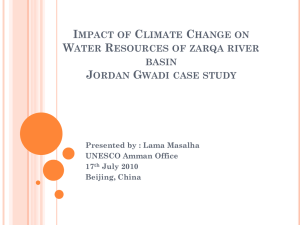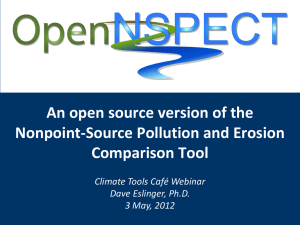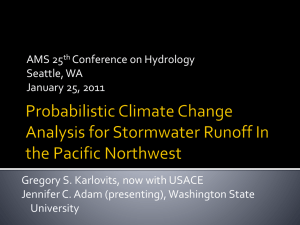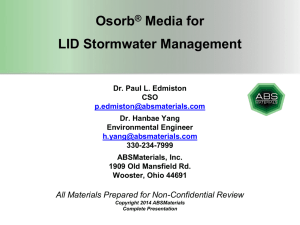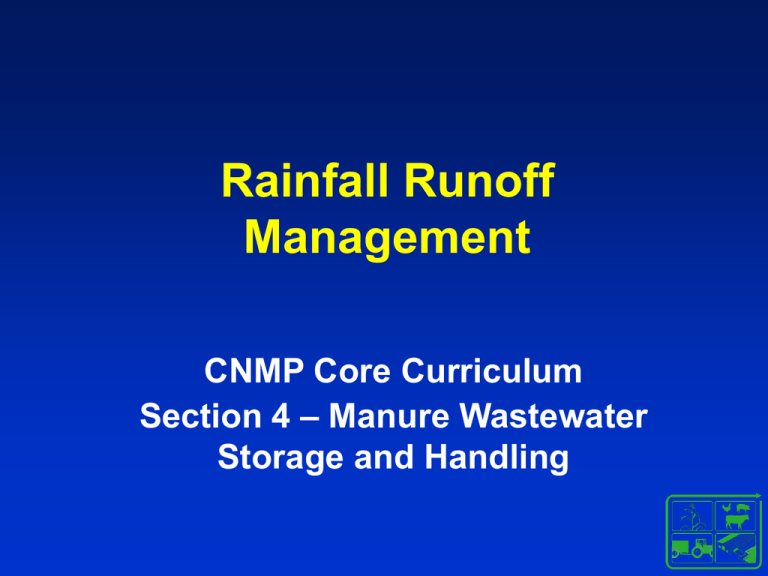
Rainfall Runoff
Management
CNMP Core Curriculum
Section 4 – Manure Wastewater
Storage and Handling
CNMP Development
Core Training Curriculum
These course materials have been developed as a
cooperative effort between five land-grant universities
and The Natural Resources Conservation Service.
Copyright Information
Ames, Iowa 50011, (515) 294-4111.
Copyright © 1995-2006, Iowa State University
of Science and Technology. All rights reserved.
Objectives
1. Keep the clean water clean
2. Recognize rainfall runoff effects on:
• storage volume in liquid manure systems
• application logistics and nutrient content
Required Materials
• Animal Waste Management Field
Handbook, Part 651, Chapter 10,
Agricultural Waste Management System
Component Design.
• NRCS Conservation Practice Standard 558
Roof Runoff Structure.
• Supplemental Resources
– AWM and NOAA addresses and resources
Rainfall Runoff Management
Rainfall Runoff Management
Divert Clean Water
Rainfall Runoff Management
Clean Water Diversion
Rainfall Runoff Management
Roof Runoff
Rainfall Runoff Management
Runoff Volume Characteristics
1. Rainfall Amount
2. Infiltration
3. Evaporation
4. Drainage Area
Rainfall Runoff Factors to
Consider:
1. Normal precipitation from runoff area
2. Normal precipitation minus evaporation
on Storage Structure
3. Emergency Storm from runoff areas
4. Emergency Storm on Storage Structure
Runoff Management
Normal Precipitation and Evaporation is
based on County and Weather Station
rainfall record data.
Runoff volume is based on this climate data
and Runoff Curve Number information.
Normal
Precipitation
Climate Data
Sources:
*AWM
Software
*NOAA
*State or Local
Month
Prec. (in)
Evap. (in)
January
4.73
1.60
February
4.32
1.90
March
5.85
3.00
AWM Data:
April
4.24
4.00
State: TN
May
4.82
4.90
June
3.80
5.50
County:
Loudon
July
5.08
5.60
August
3.86
5.20
September
3.41
4.30
October
3.29
2.90
November
4.27
1.80
December
4.83
1.70
Totals 52.50
42.40
Typical
Station:
TN5158
25 Yr, 24-Hr
Storm Event:
5.6 inches
Evaporation
Storage and treatment
facilities require an
allowance for precipitation
less evaporation for the
most critical design
period.
Evaporation
Evaporation
Factors effecting free water surface evaporation
1. Effects of salinity
2. Coloration
3. Floating surface material, such as bedding or
crusting
Local records are available for average monthly
evaporation.
The Runoff (Q) Equation Factors
•
•
•
•
Q = Runoff in inches
P = Rainfall in inches
Ia = Initial abstraction in inches
S = Potential maximum retention
after runoff begins in inches
Runoff Curve Number (RCN or CN)
• CN = 1000/(10 + S)
• The RCN’s were developed by
examining rainfall runoff data from
small agricultural watersheds
Runoff Depth for selected CN’s
and rainfall amounts
Rainfall (in)
CN=60
CN=80
CN=95
4.0
0.76
2.04
3.43
6.0
1.92
3.78
5.41
8.0
3.33
5.63
7.40
Infiltration
Cover description
Curve Numbers for
hydrologic soil
group
Cover type & hydrologic condition
A
B
C
D
Pasture, grassland, or range, good
condition
39
61
74
80
Bare soil, pervious areas, no vegetation
77
86
91
94
Impervious areas, paved lots, roofs,
driveways
98
98
98
98
Infiltration
Runoff Factors:
*soil hydrologic
characteristics
*type of cover
Infiltration
Runoff Curve
Number (RCN) of 90
is representative of
an unpaved or
unsurfaced feedlot
A paved or surfaced
feedlot typically has a
RCN of about 97
Infiltration
Month
Oct.
Nov.
Dec.
Jan.
Feb.
Mar.
Total
Precip
(inches)
3.18
2.60
2.34
1.96
2.57
3.04
Runoff
%
(inches)
36
1.14
27
0.7
24
0.56
20
0.39
20
0.51
22
0.67
3.97
(Runoff from an earth feedlot near Dallas, TX.)
Class Example:
•
Calculate the runoff depth from a 6-inch
rainfall:
1. On a pasture with good hydrologic
conditions and “B” hydrologic soil group
2. For an unsurfaced feedlot with a RCN of 90
(Hint: look at slide #19 & #20)
Class Example:
1. From slide 19- CN is 61; & slide 18 with
CN of 61, the runoff depth can be
interpolated for the 6-inch rainfall to be
2.01 inches
2. From slide 18, CN of 90, the runoff
depth from interpolation is 4.86 inches
(Note: same rainfall, over twice runoff on feedlot)
Determining Runoff Volume
• Runoff Volume is dependent on:
– Surface area
– Rainfall depth
– Surface type (paved vs. unpaved)
• Maps in Appendix 10C of AWMFH can be
used to determine runoff volumes from
surfaced or unsurfaced feed lots
– Surfaced, CN 97
– Unsurfaced, CN 90
Determining Runoff Volume
Runoff Volume =
Surface Area (ft2) x
Rainfall (ft) x
(% Runoff from Surface ÷ 100)
In-Class Exercise
A 6.0 acre open beef feedlot is being
constructed near Ames, IA. The annual
rainfall at Ames, IA is 30 inches. The
earthen portion of the lot is 5.5 acres, and
the concrete portion is 0.5 acres. Using the
Annual Runoff charts for surfaced (CN 97)
and unsurfaced (CN90) feedlots, determine
the volume of runoff that will leave the 6
acre feedlot in Ames, IA.
In-class Exercise
1 acre = 43,560 ft2
Concrete Area _______ ft2
Earthen Lot Area _______ ft2
Annual Rainfall _______ ft
CN 90 Runoff Percentage ______ %
CN 97 Runoff Percentage ______ %
In-class Exercise
Runoff Volume = Area x Rainfall x (CN % Runoff ÷
100)
Total Runoff Volume =
Runoff Volume earthen + Volume of Runoff
concrete
•
•
•
•
•
Concrete Area 21,780 ft2
Earthen Lot Area 239,580 ft2
Annual Rainfall 2.5 ft
CN 90 Runoff Percentage 23 %
CN 97 Runoff Percentage 55 %
In-class Exercise
Runoff Vol.earthen= Area x Rainfall x (CN 90 % Runoff ÷ 100)
= 239,580 ft2 x 2.5 ft x 0.23
= 137,760 ft3
Runoff Vol. concrete= Area x Rainfall x (CN 97 % Runoff ÷ 100)
= 21,780 ft2 x 2.5 ft x 0.55
= 29,950 ft3
Total Runoff Vol. = Runoff Vol. earthen + Runoff Vol.concrete
= 137,760 ft + 29,950 ft
= 167,710 ft3
Runoff Management
AWM uses a more conservative
approach to estimating runoff from runoff
areas as compared to tables in AWMFH.
AWM includes a climate database with
monthly precipitation and evaporation.
Runoff Management
AWM allows input based on Pervious and Impervious
watershed
Impervious - concrete, roofs
Curve Number of 98 - cannot be modified
Pervious - manure pack or other CN of 90 - can modify
Emergency Storm Runoff Variables
1) Depth of 25year, 24-hour
storm on storage
structure
2) Depth of 25year, 24-hour
storm from runoff
areas to storage
structure
4 Components of Runoff
1
4
3
2
Determining Rainfall Runoff
Amounts
Site Visit – Sample CNMP Dairy
Determining Rainfall Runoff Amounts
Identify Areas that contribute runoff
Determining Rainfall
Runoff Amounts
Rainfall on
Open and
Concrete Lots
To Storage pond
Determining Rainfall
Runoff Amounts
Runoff from roofs
Roof Area
Roof Area
Determining Rainfall Runoff
Amounts
Rainfall on Storage Structure
Determining Rainfall Runoff Amounts
Concrete Areas
that Contribute
Runoff
Silage Bunker Runoff Condition when Full
Drain- to storage pond
Determining
Rainfall
Runoff Amounts
Silage Bunker Condition when
empty
To Storage pond
Runoff =
6000 ft2
Determining Rainfall Runoff Amounts
Impervious Areas
Roof Runoff:
Concrete Lot:
Roofed Feedbunk:
Silage Bunker:
Total: 30,420 ft2
10,000
13,100
1,320
6,000
ft2
ft2
ft2
ft2
Determining Rainfall Runoff Amounts
30,420 sf
Total
Determining Rainfall Runoff
Amounts
1. Assuming a sufficient storage of 90 days.
2. What can we do to reduce runoff into the
storage structure and increase the storage
period?
3. Why would you need more than 90 days of
storage?
Determining Rainfall Runoff
Amounts
1. What can we do to reduce runoff into the
storage structure and increase the storage
period?
• Enlarge pond, gutter roof, diversions
2. Why would you need more than 90 days of
storage?
• Land application restraints, climate, crop
needs, etc
Critical Storage Interval
• Based on initial site
conditions, the critical storage
interval for the sample CNMP
dairy was determined to be 151
days, November - March
Determining Rainfall Runoff Amounts
20,420 ft2
What If we Gutter 10,000 sq ft?
Determining Rainfall Runoff Amounts
Adequate storage for 120 to
150 days; enough to survive
critical winter months of Dec
thru March
by Guttering
Determining Rainfall Runoff Amounts
How much clean water is removed by guttering?
115,980 cu. Ft. (all runoff areas)
-77,850 cu. Ft.
38,130 cu. Ft. (clean water removed)
38,130 cu. Ft. x 7.48 gallons/ cu. Ft. = 285,212 gallons
Benefits of Guttering:
1) 10 to 12 hours less pumping per year
2) storage period is increased (120 to 150 days)
3) low cost ($6.00 linear foot)
$6.00 x 150 linear feet = $1000 to $2000
Determining Rainfall Runoff Amounts
10,420 ft2
What if we install more roofs & gutters?
Determining Rainfall Runoff Amounts
Adequate storage for 180 days;
IDEAL
by
Guttering and Roofing
Determining Rainfall Runoff Amounts
Roofing?
115,980 cu. Ft. (runoff from all areas)
-39,730 cu. Ft.
76,250 cu. Ft. (clean water removed)
76,250 cu. Ft. x 7.48 gallons/ cu. Ft. = 570,350 gallons
Benefits of Roofing & guttering:
1) 20 hours less pumping per year
2) storage period is increased
Disadvantage:
COST - $5.00 sq. ft. x 10,000 sq. ft. = $50,000
Decision-maker's Alternatives
GIVEN: It was determined that
existing storage capacity is not
adequate to last through winter
months.
SOLUTION: Look at the
previous alternatives and
discuss each with the
decision-maker.
Decision-maker's Alternatives
Alternatives:
>>>>
Objectives
met: >>>>
Cost: >>>>
#1
#2
Increase
Gutter existing
storage
roof (10,000 sf)
structure
Increased Increased storage
storage
(to 120-150 days)
Reduced pumping
time
Moderate
Low
$15k-$20k
$6/ linear ft
$1k-$2k
#3
#2 plus additional
roofing & guttering
(10,000 sf)
Increased storage
(to 180 days)
Reduced pumping
time
High
Roof $5/sq ft =
$50k + $2 = $52k
Runoff Management Summary
1. Keep the clean water clean (diversions, roofs &
gutters)
2. Evaluate and appropriately collect
contaminated runoff into storage structures or
properly treat runoff from the heavy use areas
(pervious or impervious)
3. Consider the effect of rainfall runoff on
application logistics and nutrient content of the
waste material
4. Design a runoff management system with
adequate capacity
Questions
or
Comments?
Gutter Design Procedure
1) Compute the capacity of the selected gutter size
2) Compute the capacity of the downspout
3) Determine whether the system is controlled by
the gutter capacity or downspout capacity and
adjust number of downspouts if desired
4) Determine the roof area that can be served
Gutter Position
Gutter Design
Final Step:
•Adequate discharge pipeline or trough
based on gutter/downspout design
capacity
•Material Quality



